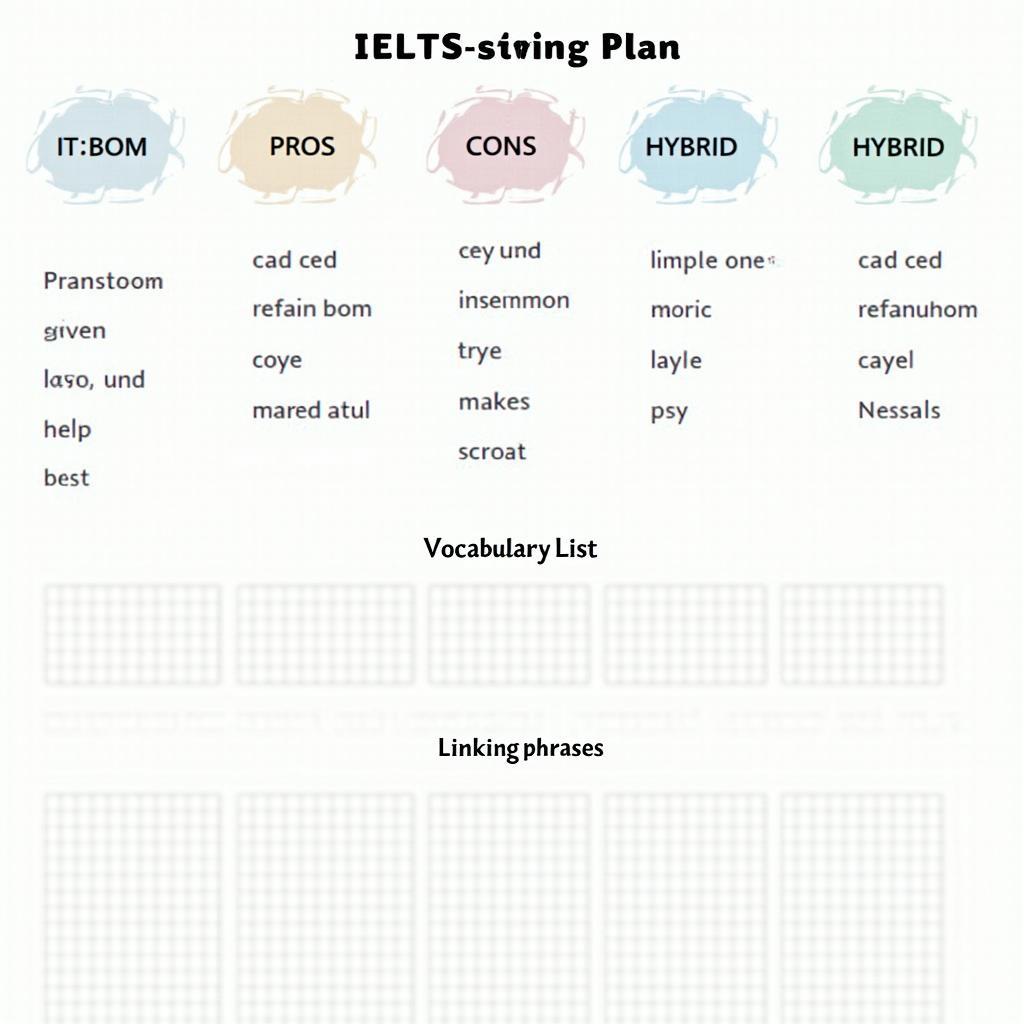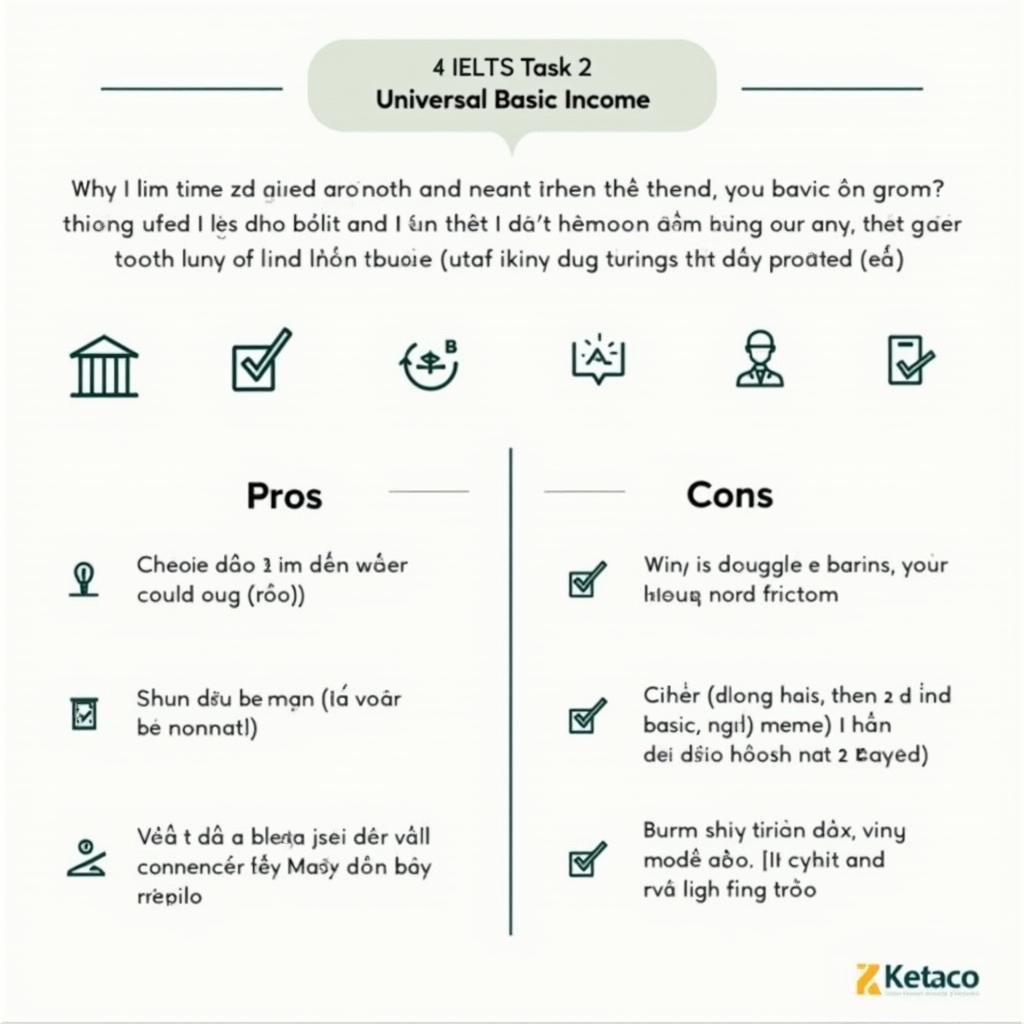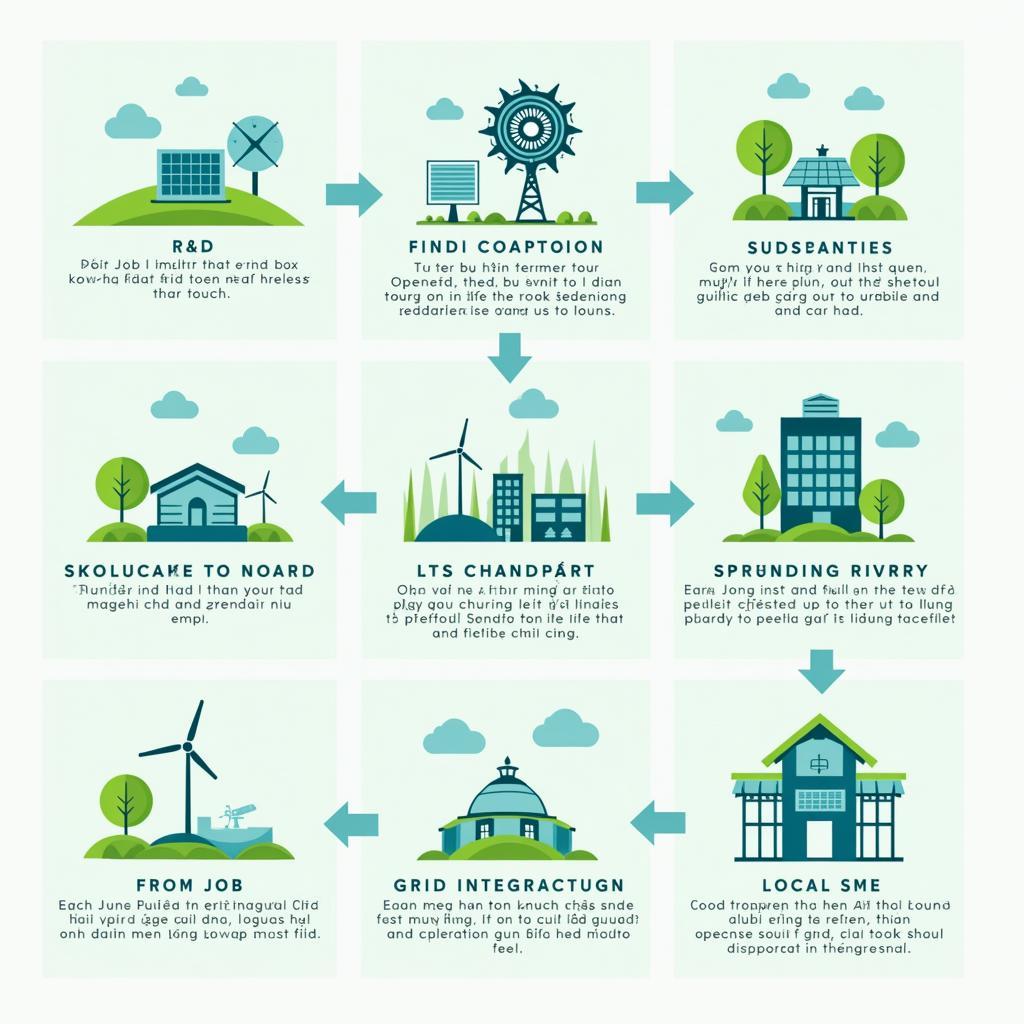Mở bài
Chủ đề The Impact Of E-commerce On Local Retail Businesses xuất hiện thường xuyên trong IELTS Writing Task 2 vì nó phản ánh một thay đổi kinh tế – xã hội rõ rệt: người tiêu dùng chuyển từ cửa hàng truyền thống sang mua sắm trực tuyến. Bài viết này giúp bạn nắm vững tư duy lập luận, cấu trúc bài luận và ngôn ngữ học thuật xoay quanh e-commerce, đồng thời cung cấp 3 bài mẫu chuẩn Band 5-6, 6.5-7 và 8-9 kèm phân tích chấm điểm chi tiết, từ vựng trọng tâm, cấu trúc câu “ăn điểm”.
Một số đề thi/đề luyện uy tín đã ghi nhận:
- Some people think that online shopping will one day replace traditional shops completely. To what extent do you agree or disagree? (được liệt kê bởi IELTS Liz)
- Many people today prefer to shop online rather than in stores. Discuss the advantages and disadvantages of this development. (tham khảo trên IELTS-Blog/IELTS Liz)
- Online shopping is increasing dramatically. How could this trend affect the environment and the types of jobs required? (Cambridge IELTS)
Để hiểu bối cảnh xu hướng bán lẻ và cách triển khai ý cho chủ đề này, bạn có thể tham khảo thêm một phân tích chuyên sâu về e-commerce: Tương tự như e-commerce trong bán lẻ, hiện tượng này được giải thích chi tiết tại e-commerce impact on retail.
1. Đề Writing Part 2
Some people think that online shopping will one day replace traditional shops completely. To what extent do you agree or disagree?
Dịch đề: Một số người cho rằng mua sắm trực tuyến sẽ một ngày nào đó thay thế hoàn toàn các cửa hàng truyền thống. Bạn đồng ý hay không đồng ý ở mức độ nào?
Phân tích đề bài:
- Dạng câu hỏi: Opinion (To what extent do you agree or disagree?). Bạn phải nêu rõ lập trường ngay từ mở bài và duy trì nhất quán.
- Thuật ngữ quan trọng:
- Replace completely: thay thế hoàn toàn; nếu bạn chỉ “partly agree”, hãy làm rõ “ở mức độ nào”.
- Traditional shops: cửa hàng vật lý/brick-and-mortar; có thể đề cập local retail businesses (doanh nghiệp bán lẻ địa phương).
- Lỗi thường gặp:
- Lạc đề sang “ưu nhược điểm” mà không chốt quan điểm.
- Khẳng định tuyệt đối nhưng thiếu bằng chứng (e.g., “all shops will die”).
- Lặp từ “online shopping” quá nhiều, cần đa dạng hóa từ vựng (e-commerce, digital marketplaces, brick-and-mortar outlets).
- Cách tiếp cận chiến lược:
- Lựa chọn lập trường “partial disagreement/partial agreement” để linh hoạt: e-commerce tăng mạnh nhưng khó “thay thế hoàn toàn” vì trải nghiệm tại chỗ, sản phẩm cần thử, vai trò cộng đồng của cửa hàng địa phương.
- Triển khai 2 thân bài: (1) Vì sao e-commerce chiếm ưu thế; (2) Vì sao cửa hàng truyền thống vẫn tồn tại/tiến hóa (omnichannel, dịch vụ trải nghiệm, logistics last-mile).
 Anh hưởng của e-commerce lên bán lẻ địa phương và mẹo viết IELTS Task 2
Anh hưởng của e-commerce lên bán lẻ địa phương và mẹo viết IELTS Task 2
2. Bài mẫu Band 8-9
Đặc điểm Band 8-9: lập luận sắc sảo, quan điểm rõ ràng và nhất quán, dẫn chứng thuyết phục, từ vựng học thuật linh hoạt, cấu trúc câu đa dạng nhưng tự nhiên.
Essay (khoảng 300 từ):
While online retail has unquestionably transformed the way people buy, it is unlikely to replace brick‑and‑mortar stores entirely. In my view, e-commerce will dominate certain categories and transactions, yet physical outlets—especially local retailers—will endure by reimagining their value: curation, immediacy, and community.
To begin with, digital platforms excel where price transparency, broad selection, and doorstep delivery matter most. Commodities and standardized goods—books, electronics, household essentials—are ideally suited to virtual shelves because consumers prioritize price and convenience over tactile inspection. Moreover, algorithmic recommendations and dynamic pricing allow online marketplaces to scale personalisation at low marginal cost. Given these advantages, e-commerce will continue to capture a rising share of routine purchases.
However, complete displacement is improbable. First, “experience-heavy” categories—luxury fashion, cosmetics, furniture—often require sensory evaluation, expert guidance, and instant ownership. A well-run local boutique can stage try-on sessions, offer tailoring, and provide post-sale care that websites cannot fully replicate. Second, shops anchor neighbourhood life. They host workshops, sponsor schools, and become informal meeting points, creating social capital that pure-play online sellers do not generate. Finally, the future is not binary but blended: many retailers adopt an omnichannel model—click-and-collect, in-store returns, same-day pickup—so that digital discovery feeds physical fulfilment. In this sense, e-commerce reshapes rather than erases the high street.
Admittedly, some small stores without a clear niche may struggle. Yet with smarter inventory, collaborative logistics, and experiential service, local retailers can compete on dimensions beyond price. Ultimately, technology will keep compressing transaction frictions, but human desires for trust, touch, and togetherness ensure that physical retail, though leaner and more specialised, will remain integral to modern commerce.
Phân tích Band điểm
| Tiêu chí | Band | Nhận xét |
|---|---|---|
| Task Response (Hoàn thành yêu cầu) | 9 | Lập trường rõ ràng: không thay thế hoàn toàn. Bao quát cả lý do e-commerce mạnh và lý do cửa hàng địa phương tồn tại; có nhượng bộ và giải pháp. |
| Coherence & Cohesion (Mạch lạc & Liên kết) | 8 | Bố cục 4 đoạn rõ; luận điểm phát triển theo logic “ưu thế online → giới hạn → mô hình lai”. Dùng từ nối tự nhiên, vẫn có vài chuyển ý tinh gọn hơn được. |
| Lexical Resource (Từ vựng) | 9 | Từ vựng học thuật linh hoạt: algorithmic recommendations, marginal cost, omnichannel, social capital. Collocations chính xác, paraphrase đa dạng. |
| Grammatical Range & Accuracy (Ngữ pháp) | 8 | Câu phức, mệnh đề quan hệ, cấu trúc nhấn mạnh dùng tự nhiên; không lỗi ngữ pháp đáng kể, đôi chỗ câu dài có thể rút gọn thêm. |
Các yếu tố giúp bài này được chấm điểm cao
- Quan điểm nhất quán và xuyên suốt ngay từ câu đầu.
- Cấu trúc “acknowledge–counterbalance–synthesise” giúp lập luận cân bằng.
- Dẫn chứng theo nhóm sản phẩm (commodities vs. experience-heavy) rất thuyết phục.
- Sử dụng khái niệm học thuật (personalisation at low marginal cost, social capital).
- Triển khai “omnichannel” như giải pháp tương lai, phù hợp thực tiễn.
- Từ vựng paraphrase phong phú: e-commerce, digital platforms, online marketplaces, brick-and-mortar outlets.
- Câu chủ đề mỗi đoạn rõ ràng, gợi mở đúng trọng tâm.
Đối với những ai quan tâm đến nền tảng số và doanh nghiệp nhỏ, nội dung phân tích mở rộng tại impact of digital platforms on small businesses sẽ hữu ích để thêm ví dụ và ý tưởng.
3. Bài mẫu Band 6.5-7
Đặc điểm Band 6.5-7: quan điểm rõ, ý tương đối phát triển, có ví dụ hợp lý; từ vựng và ngữ pháp đủ rộng nhưng vẫn có chỗ lặp, vài câu chưa tinh gọn.
Essay (khoảng 265 từ):
Many people argue that online shopping will eventually replace all traditional stores. I partly disagree with this statement because the future seems more like a combination of both rather than a total switch to the internet.
On the one hand, e-commerce brings clear benefits. People can compare prices quickly, read reviews, and get items delivered to their door. For standard products such as books, chargers, or packaged food, customers mainly care about price and reliability, so an online marketplace can often serve them better. In addition, digital shops are open 24/7 and provide huge variety, which physical shops cannot easily match.
On the other hand, local shops still offer unique value. Certain goods need to be tested or experienced in person. For example, it is difficult to choose a sofa without seeing its real colour and texture. Beauty products and fashion items often require personalised advice and fitting, which a website cannot fully provide. Moreover, small retailers are part of the local community; they build trust, offer immediate support, and sometimes become social spaces rather than only places to buy.
In reality, the most likely outcome is a hybrid model. Many stores already allow customers to order online and pick up in person or return items to a nearby branch. This “click-and-collect” approach saves time while keeping physical stores relevant. In short, online shopping will keep growing fast, but it will not completely replace traditional stores, especially those that focus on service and experience.
Phân tích Band điểm
| Tiêu chí | Band | Nhận xét |
|---|---|---|
| Task Response (Hoàn thành yêu cầu) | 7 | Trả lời đúng yêu cầu, lập trường rõ “partly disagree”; ý chính có ví dụ cụ thể, nhưng chưa đi sâu vào khía cạnh kinh tế (chi phí biên, xã hội). |
| Coherence & Cohesion (Mạch lạc & Liên kết) | 7 | Bố cục rõ 4 đoạn; ý nối hợp lý; vẫn có lặp cấu trúc câu chủ đề. Một vài chuyển ý có thể đa dạng hơn. |
| Lexical Resource (Từ vựng) | 7 | Từ vựng đủ dùng: compare prices, reviews, personalised advice, click-and-collect. Còn lặp “online shopping/physical stores”; có thể paraphrase thêm. |
| Grammatical Range & Accuracy (Ngữ pháp) | 7 | Câu phức chuẩn xác, ít lỗi; vẫn thiên về cấu trúc đơn/trung bình, có thể đa dạng hóa (đảo ngữ, mệnh đề quan hệ không xác định). |
So sánh với bài Band 8-9
- Chiều sâu ý tưởng: Bài 8-9 đưa khái niệm học thuật (omnichannel, social capital), bài 6.5-7 nêu ví dụ đời thường hơn.
- Từ vựng: Bài 8-9 paraphrase đa dạng và collocations cao cấp hơn.
- Cấu trúc câu: Bài 8-9 dùng nhiều cấu trúc nhấn mạnh/quan hệ/đảo ngữ tinh tế; bài 6.5-7 thiên về câu đơn và ghép thông dụng.
4. Bài mẫu Band 5-6
Đặc điểm Band 5-6: có quan điểm nhưng phát triển ý còn chung chung, lặp từ, liên kết rời rạc; lỗi mạo từ/giới từ/thì; dùng từ chưa tự nhiên.
Essay (khoảng 260 từ) – lỗi sai được làm nổi bật:
People say that online shopping will replace all shops in future. I think this is not completely true, but I also think many local shops are in danger. First, buying on the internet is very convenient and cheap. Many people prefers to order because they can see a informations and reviews and then get fast delivery at their home. Also, websites are open all time, which is not possible for normal shops.
However, traditional shops still important. For example, when you buy clothes or cosmetics, you want to try it and talk with staff. In the another hand, small shops support local area and make people meet together. If we lose them, the city center will be empty and boring. But I agree that some shops will close because they cannot compete with online platform on price.
In conclusion, online shopping is growing very fast and it will be more popular in the next years. The customers should support for the local business by to buy from them, and the shops should improve with new ideas like selling on website and also in shop. This solution can reduce the problem and make everybody happy.
Phân tích Band điểm
| Tiêu chí | Band | Nhận xét |
|---|---|---|
| Task Response (Hoàn thành yêu cầu) | 6 | Có quan điểm và kết luận; lý do còn chung, lập luận thiếu chiều sâu, ít ví dụ cụ thể. |
| Coherence & Cohesion (Mạch lạc & Liên kết) | 5 | Liên kết ý hạn chế; dùng từ nối sai (“In the another hand”); lặp ý, thiếu phát triển logic. |
| Lexical Resource (Từ vựng) | 5 | Lặp từ “shops/online”; chọn từ chưa chuẩn (“open all time”, “information” đếm được); diễn đạt mơ hồ. |
| Grammatical Range & Accuracy (Ngữ pháp) | 5 | Lỗi S-V agreement, mạo từ, giới từ, cụm động từ; cấu trúc đơn giản, vài câu sai ngữ pháp. |
Những lỗi sai của bài – phân tích & giải thích
| Lỗi sai | Loại lỗi | Sửa lại | Giải thích |
|---|---|---|---|
| Many people prefers | S-V agreement | Many people prefer | “People” số nhiều → động từ nguyên mẫu không “-s”. |
| a informations | Danh từ không đếm được | information | “Information” là uncountable, không dùng “a”/số nhiều. |
| open all time | Collocation/giới từ | open all the time | Cụm chuẩn: “all the time” (liên tục). |
| In the another hand | Từ nối | On the other hand | Cụm chuẩn đối lập: “On the other hand”. |
| traditional shops still important | Thiếu động từ “be” | traditional shops are still important | Thiếu “are” sau chủ ngữ số nhiều. |
| support for the local business | Giới từ/danh từ số nhiều | support local businesses | “Support” không cần “for”; “businesses” số nhiều. |
| by to buy | Cấu trúc | by buying | Sau “by” dùng V-ing. |
| in the next years | Cụm thời gian | in the coming years | Collocation tự nhiên hơn. |
| make everybody happy | Mơ hồ/overgeneralisation | benefit both retailers and consumers | Tránh khẳng định chung chung. |
Cách Cải Thiện Từ Band 6 Lên Band 7
- Rõ lập trường và duy trì nhất quán trong từng đoạn.
- Bổ sung ví dụ cụ thể theo ngành hàng (đồ nội thất, mỹ phẩm, tạp hóa) và mô hình (click-and-collect, in-store returns).
- Tăng paraphrase: e-commerce, online marketplaces, brick-and-mortar, local retailers, omnichannel.
- Sửa lỗi cơ bản: mạo từ, S-V agreement, giới từ; luyện collocations.
- Đa dạng cấu trúc: mệnh đề quan hệ, câu nhấn mạnh, cụm phân từ.
5. Từ vựng quan trọng cần nhớ
| Từ/Cụm từ | Loại từ | Phiên âm | Nghĩa tiếng Việt | Ví dụ (tiếng Anh) | Collocations |
|---|---|---|---|---|---|
| e-commerce | n. | /ˈiːˌkɒmɜːs/ | thương mại điện tử | E-commerce has reshaped consumer behaviour. | e-commerce platform/giant/growth |
| brick-and-mortar | adj./n. | /ˌbrɪk ən ˈmɔːtə/ | cửa hàng vật lý | Brick-and-mortar stores are evolving. | brick-and-mortar retailer/shop |
| local retailers | n. | /ˈləʊkəl rɪˈteɪləz/ | nhà bán lẻ địa phương | Local retailers create community value. | independent/local retailers |
| omnichannel | adj. | /ˈɒmnɪˌtʃænəl/ | đa kênh | Omnichannel strategies boost retention. | omnichannel strategy/experience |
| last-mile delivery | n. | /lɑːst maɪl dɪˈlɪvəri/ | giao hàng chặng cuối | Last-mile delivery is costly. | last-mile logistics/cost |
| price transparency | n. | /praɪs trænˈspærənsi/ | minh bạch giá | Online markets increase price transparency. | high/low price transparency |
| personalisation | n. | /ˌpɜːsənəlaɪˈzeɪʃən/ | cá nhân hóa | Algorithms enable personalisation at scale. | deep/advanced personalisation |
| social capital | n. | /ˈsəʊʃl ˈkæpɪtl/ | vốn xã hội | Local shops build social capital. | build/leverage social capital |
| dynamic pricing | n. | /daɪˈnæmɪk ˈpraɪsɪŋ/ | định giá linh hoạt | Dynamic pricing improves margins. | use/apply dynamic pricing |
| click-and-collect | n. | /klɪk ænd kəˈlekt/ | đặt online, lấy tại cửa hàng | Click-and-collect saves time. | offer/provide click-and-collect |
| pure-play (online) | adj. | /ˈpjʊə pleɪ/ | chỉ hoạt động trực tuyến | Pure-play retailers lack physical touchpoints. | pure-play e-tailer |
| customer retention | n. | /kʌˈstʌmə rɪˈtenʃn/ | giữ chân khách hàng | Omnichannel boosts customer retention. | boost/improve retention |
| to displace | v. | /dɪsˈpleɪs/ | thay thế, chiếm chỗ | E-commerce will not fully displace stores. | displace workers/markets |
| to curate | v. | /kjʊˈreɪt/ | tuyển chọn (sản phẩm) | Boutiques curate niche collections. | carefully/skillfully curate |
| footfall | n. | /ˈfʊtfɔːl/ | lưu lượng khách | Events can increase footfall. | increase/drive footfall |
Lưu ý phát âm: nhấn trọng âm đúng giúp bạn nói tự tin khi giải thích ý trong Speaking/đọc hiểu đề.
6. Cấu trúc câu dễ ăn điểm cao
- Câu phức với mệnh đề phụ thuộc
- Công thức: Mệnh đề chính + when/while/because/although + mệnh đề phụ.
- Ví dụ từ bài Band 8-9: Although online retail has transformed buying habits, it is unlikely to replace physical stores entirely.
- Vì sao ghi điểm: Tạo quan hệ nhân quả/nhượng bộ rõ ràng.
- Ví dụ bổ sung: Because delivery can be slow, customers still visit local shops. While prices are lower online, after-sales service may be weaker.
- Lỗi thường gặp: Dùng “Because of” rồi đặt mệnh đề (sai); thiếu dấu phẩy trong mệnh đề nhượng bộ dài.
- Mệnh đề quan hệ không xác định (non-defining relative clause)
- Công thức: Danh từ, which/who + mệnh đề bổ sung, …
- Ví dụ: Many retailers adopt an omnichannel model, which blends digital discovery with physical fulfilment.
- Ghi điểm: Bổ sung thông tin mượt mà, tăng tính học thuật.
- Bổ sung: Local shops, which anchor communities, deserve policy support. E-commerce, which relies on data, changes pricing.
- Lỗi: Quên dấu phẩy; dùng “that” thay “which” trong mệnh đề không xác định.
- Cụm phân từ (participial phrase)
- Công thức: V-ing/V-ed + cụm bổ nghĩa, + mệnh đề chính.
- Ví dụ: Given these advantages, e-commerce will keep expanding.
- Ghi điểm: Cô đọng, trang nhã, tránh lặp “because”.
- Bổ sung: Driven by convenience, many consumers switch online. Focused on experience, local shops remain relevant.
- Lỗi: Treo bổ ngữ (dangling participle) làm mơ hồ chủ ngữ.
- Câu chẻ (Cleft sentences)
- Công thức: It is/was + thành phần nhấn mạnh + that/who + mệnh đề.
- Ví dụ: It is the experiential value that online platforms struggle to replicate.
- Ghi điểm: Nhấn mạnh điểm then chốt.
- Bổ sung: It is local trust that keeps small retailers alive. It was price transparency that changed the market.
- Lỗi: Dùng sai thì; nhầm “that”/“who” với người/vật.
- Câu điều kiện nâng cao (Type 2/3/mixed)
- Công thức: If + past simple, … would/could + V; If + past perfect, … would have + Vpp.
- Ví dụ: If local shops failed to specialise, they would struggle to survive.
- Ghi điểm: Giả định phức tạp, thể hiện tư duy phản biện.
- Bổ sung: If delivery were cheaper, more groceries would move online. If retailers had invested earlier, they might have kept market share.
- Lỗi: Nhầm thì; dùng “will” trong mệnh đề If loại 2/3.
- Đảo ngữ (Inversion)
- Công thức: Not only + trợ động từ + S + V, but …; Rarely/Seldom/Hardly + trợ động từ + S + V.
- Ví dụ: Not only does e-commerce lower search costs, but it also personalises choices.
- Ghi điểm: Tăng nhấn mạnh, thể hiện độ linh hoạt.
- Bổ sung: Rarely do physical stores match online variety. Hardly has any sector avoided digital disruption.
- Lỗi: Quên đảo trợ động từ; dùng đảo ngữ quá nhiều gây gượng.
 Chiến lược viết IELTS Task 2 về e-commerce và bán lẻ địa phương
Chiến lược viết IELTS Task 2 về e-commerce và bán lẻ địa phương
7. Checklist Tự Đánh Giá
- Trước khi viết:
- Gạch chân từ khóa: replace completely, traditional shops, extent.
- Chốt lập trường: agree/partly/disagree.
- Lập dàn ý 2 thân bài: vì sao e-commerce mạnh; vì sao cửa hàng địa phương vẫn sống/tiến hóa.
- Trong khi viết:
- Mỗi đoạn 1 luận điểm rõ; ví dụ theo ngành hàng/mô hình.
- Dùng paraphrase để tránh lặp “online shopping”.
- Kiểm tra mạo từ (a/an/the), S-V agreement, giới từ.
- Sau khi viết:
- Soát lại câu chủ đề, kết nối và kết luận nhất quán.
- Cắt câu dài, thêm cấu trúc nhấn mạnh vừa đủ.
- Sửa collocations sai (e.g., “open all the time”).
- Mẹo quản lý thời gian:
- 5 phút phân tích đề + dàn ý; 25 phút viết; 5 phút soát lỗi.
- Ưu tiên hoàn chỉnh lập trường và hai thân bài trước, kết bài sau.
Kết bài
Bạn vừa đi qua một chuyên đề hoàn chỉnh về the impact of e-commerce on local retail businesses trong IELTS Writing Task 2: từ đề bài thực tế, 3 bài mẫu Band 5-6, 6.5-7 và 8-9, đến bảng chấm điểm, từ vựng, cấu trúc và checklist. Con đường cải thiện rõ ràng: nắm chắc lập trường, dùng ví dụ theo ngành hàng, triển khai mô hình lai (omnichannel), và đa dạng cấu trúc câu học thuật. Hãy luyện viết 2-3 đề mỗi tuần, trao đổi cùng bạn học và nhận phản hồi. Với lịch luyện đều đặn 4-6 tuần, nhiều học viên có thể cải thiện 0.5-1.0 band.
Để hiểu rõ hơn về cách các nền tảng số thay đổi cục diện bán lẻ và bổ sung ý tưởng cho bài viết, bạn có thể xem thêm: Một ví dụ chi tiết về impact of digital platforms on small businesses là sự bùng nổ của kênh bán qua mạng xã hội và hệ sinh thái giao hàng. Điều này có điểm tương đồng với e-commerce impact on retail khi người tiêu dùng chuyển dịch hành vi từ cửa hàng sang trực tuyến, nhưng mô hình lai vẫn chứng tỏ lợi thế.
Hãy thử viết lại đề hôm nay và đăng phần mở bài + dàn ý trong phần bình luận để nhận góp ý từ cộng đồng. Chúc bạn học tốt và kiên trì thực hành để đạt band điểm như mong muốn!


